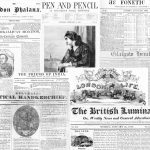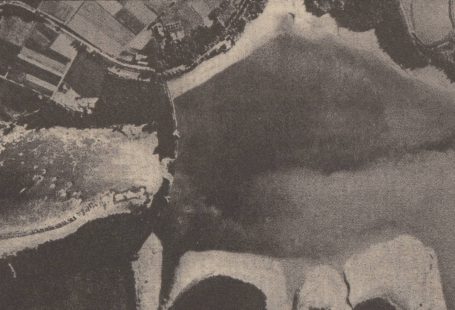Not even a month ago we celebrated reaching 55 million pages, and this week, we are celebrating adding another one million pages to The Archive, with over 56 million newspaper pages all now available to search.
In what is a truly bumper week at The Archive, we have added ten brand new newspaper titles to our collection from England and Scotland, and even from across the pond. Meanwhile, we’ve updated 28 of our existing titles, from Aberdare to Wells, with significant updates to important regional publications.
So read on to discover more about all of our new and updated titles of the week, as well as to find out more about Irish Day at the 1893 World’s Columbian Exhibition, a world’s fair that was held in Chicago to celebrate the 400th anniversary of Christopher Columbus’ arrival in the ‘New World of the Americas.’
Register now and explore the Archive
And it’s in Chicago that we begin with our first new title of the week, the Chicago Citizen, which is the second American newspaper title to join our collection, and an exclusive for The Archive. Founded in the 1880s, the Chicago Citizen was the ‘Official Newspaper of the United Irish Societies of Chicago and Cook County,’ its motto proclaiming how ‘Europe, not England, is the Mother Country of America.’
The Chicago Citizen, therefore, represented American Irish interests, with strong ties back across the Atlantic to Ireland. The city of Chicago had a large Irish population, and by the time that the Chicago Citizen was published, Chicago was the fastest growing city in world history, with a particular influx of immigrants from Eastern and Central Europe. Therefore, the Chicago Citizen was a bastion of Irish American identity, with a particular focus on Catholicism.

To this end, the newspaper contained poetry written in Gaelic, as well as stories that were often based in Ireland, such as James Murphy’s tale set against the ‘Clearances of Westmeath,’ or looks at life in Ireland, for example with a glimpse at the ‘Romantic District of Connemara.’ Meanwhile, religion played a prominent part in the Chicago Citizen with the inclusion of a ‘Catholic Church Directory,’ whilst the newspaper also reported on regional and national news.
Finally, the Chicago Citizen featured a ‘Personal Column,’ which often detailed the names of those visiting the city, as well as obituaries, anniversaries, and a list of ‘amusements’ taking place in the local area.
We return back across the pond now to Scotland, and we introduce the first of our two new Scottish titles joining us this week, which is the Falkirk Express. Founded in 1880, the Falkirk Express, or to give it its full title of the Falkirk Express, and Advertiser for the Counties of Stirling and Linlithgow, appeared every Saturday at the cost of one penny and was known as the ‘County Paper.’ Circulating ‘in Stirlingshire, the county of Linlithgow, and generally over the whole of the Midland district of Scotland,’ the Falkirk Express was Conservative in its politics and spanned four pages.

With a front page filled with advertisements, as was typical at the time, the Falkirk Express concentrated on local news, with updates from the Falkirk Ornithological Society, the Falkirk Sheriff Criminal Court, the Falkirk Town Council and the Falkirk Police Commissioners, as well as news regarding Falkirk natives, with headlines like ‘Death of a Soldier Belonging to Falkirk.’ Beyond Falkirk, the newspaper also detailed news from the district, with the latest from the likes of Larbert, Bo’ness, Airth, Polmont, Bonnybridge, Slamannan, Linlithgow, and Stirling filling its pages.
Meanwhile, the Falkirk Express, which was published in the large central Lowlands town of Falkirk, also featured poetry, serialised fiction, news from parliament as well as ‘Comments on Current Topics.’
Our second new Scottish newspaper of the week was published in Glasgow, and is the National Advertiser and Edinburgh and Glasgow Gazette. Began as the National Advertiser, this newspaper was sent to ‘the leading towns in Scotland and England,’ with the bulk of its copies being ‘distributed in Glasgow, Edinburgh, and Leith.’ Appearing every Saturday, the National Advertiser filled four pages and primarily contained advertisements and shipping intelligence.

Indeed, the National Advertiser featured a range of advertisements, promoting everything from top hats to auctions of railway shares. Furthermore, it had a focus on all things commercial; with updates, for example, from the grain markets and the Liverpool cotton market. Meanwhile, the newspaper contained news on ‘Scottish Bankrupts,’ as well as shipping intelligence from Glasgow.
By 1848 the newspaper was looking to expand its remit, the editor declaring how:
Arrangements are…being made for giving still better reports of markets, and of the general business of the country; while for the perusal of families and the ladies they will endeavour to supply such entertaining and instructive reading as shall meet approval.
At this time the National Advertiser dubbed itself ‘a very large circular,’ performing ‘its work,’ i.e. its advertising, ‘speedily and efficiently.’
From the National Advertiser to the National Independent and People’s Advocate now, which was a newspaper published in Leeds from 1873. Circulating in ‘all parts of England,’ this independent newspaper appeared every Friday and advocated ‘the Tichborne and Commoners’ Questions, the Repeal of the Compulsory Clauses of the Vaccination Acts, and the General Advancement of the Masses.’ The Tichborne question was a Victorian legal cause célèbre that centred on a claim made to the Tichborne baronetcy, after heir Roger Tichborne had been missing for many years.

The National Independent, was, therefore, a reforming newspaper, containing within its pages the ‘Manifesto of the National Reform Union.’ It also focussed on local news from Leeds, with a look at the city magistrates, as well as reporting on national and international news. The Yorkshire newspaper also featured poetry, serialised fiction, as well as letters to the editor, who was one Edward Foster.
We remain in Yorkshire to introduce our next new title of the week, which is the Harrogate Advertiser and Weekly List of the Visitors. Serving the popular spa town of Harrogate, where the healing waters were discovered in the sixteenth century, the Harrogate Advertiser was established in 1836 and continues to be published to this day, with the tagline ‘News you can trust since 1836.’

Conservative in its politics during the Victorian era, the Harrogate Advertiser circulated in Leeds, York, Ripon, Knaresborough, Otley, and Wetherby, and ‘being largely purchased by visitors in the town, it is sent to all parts of England, Scotland, and Ireland.’ Visitors to Harrogate were at the heart of this publication, even bringing up the price of the newspaper during the season from one penny to two. Indeed, during the season the Harrogate Advertiser featured a list of visitors to the town, with visitors being advised:
To prevent mis-spelling of Names, and to ensure general accuracy, Visitors are respectfully invited to call and leave their addresses at our Office in High Harrogate, or at 9, Royal Parade, Harrogate Wells. No charge made for insertion.
Meanwhile, the Harrogate Advertiser was an incredibly varied and entertaining title, one of its mainstays being ‘popular ghost stories.’ It also contained ‘Local and General Intelligence,’ for example looking at the ‘Rain-Fall at Harrogate,’ as well as news from the Harrogate Improvement Commissioners and the Knaresborough and Harrogate Building Society.

Furthermore, the newspaper featured ‘District Intelligence,’ as well as ‘useful information’ for those visiting the town, printing the train timetable for Harrogate, and details regarding places of worship, banks, ‘places of recreation’ and the post office. Finally, the Harrogate Advertiser published the names of those who had passed away, and of those who had tied the knot.
We turn now to Liverpool for our next new title of the week, which dubbed itself ‘The Oldest Daily Paper in the English provinces,’ having been established in 1827. ‘Constantly referred to by mercantile houses in the principal maritime towns of Great Britain and abroad,’ the Liverpool Shipping Telegraph and Daily Commercial Advertiser boasted ‘a more extended commercial circulation than that of any other shipping paper published out of London,’ its circulation being ‘more than double that of any similar paper published in the Province.’
The Liverpool Shipping Telegraph, therefore, contained varied and detailed shipping intelligence, filling four pages and costing one pence. Circulating ‘extensively amongst the merchants, shippers, shipbrokers, commercial classes, &c., of Liverpool, and other important maritime ports at home and abroad,’ the newspaper contained details of vessels sailing from Liverpool and other ports, as well as news on ‘foreign packets.’

Furthermore, the Liverpool Shipping Telegraph featured a fascinating ‘Dock Directory,’ which gave details of docks across Liverpool, such as Queen’s Dock and Toxteth Dock, listing the width and depth of the docks’ entrances, their tide timetables, and the names of the ships and their masters currently docked. The newspaper also contained a segment entitled ‘Vessels Spoken,’ which featured details of correspondence with ships that were sailing.
With ‘a circulation greater than the daily and weekly Shipping Papers of the district added together,’ the Liverpool Shipping Telegraph was eventually merged with the Liverpool Journal of Commerce.
Another commercially minded newspaper joining The Archive this week is the Derby Exchange Gazette, an early Derby newspaper which began as the Derby Corn Exchange Gazette and eventually became known as the Derby Gazette and County Journal and Advertiser. Appearing every Friday at the cost of one penny, this title was bought out by George Wilkins in 1860, who soon renamed the newspaper the Derby Gazette.

Circulating ‘largely in Derby and the towns and villages of the southern division of the county,’ with a guaranteed weekly circulation of 7,000 copies, the Derby Exchange Gazette filled four pages, its main focus being local news. For example, the newspaper contained updates from the Derby Dispensary, the Trinity Church Working Men’s Association, and the new congregational church being built in the city. It also featured the latest from the Borough Police Court and the Derbyshire Quarter Sessions, alongside ‘District Intelligence’ from the likes of Heanor, Breadsall, Loscoe, Quarndon, Kilburne, Belper, Ashby-de-la-Zouche, Birchwood, Alfreton, Spondon, and Chesterfield.
Meanwhile, the Derby Exchange Gazette published notices of marriages and deaths, as well as details of those who had been declared bankrupt. The newspaper also featured poetry, news from abroad, and items of ‘General News.’
We travel to the South of England for our final three new titles of the week, beginning with Essex’s Loughton and District Advertiser, a free publication that appeared on the first of every month. First published in February 1887 in the town of Loughton, it circulated throughout that town as well as in Buckhurst Hill and the surrounding neighbourhood.

The main feature of this publication was its adverts, which promoted an array of local businesses, from butchers to milliners, from chemists to upholsterers. These adverts were often fairly large and illustrated, filling the four pages of the Loughton and District Advertiser. The newspaper was divided into two columns; as editor Moreland Hickman stated, it was ‘carried out in an useful and attractive form.’ Hickman also promised that alongside the adverts, ‘local information will be frequently inserted, besides occasional Parochial items of news.’ Indeed, the newspaper went beyond this, also featuring essays and comment, with a look at ‘Parochial Management,’ for example.
Our penultimate new title of the week hails from Kent, and is the Medway News, which was published in Chatham from 1855. Originally titled the Military Chronicle and Spectator, the newspaper became the Chatham News and Rochester, Strood, Brompton and Gillingham Advertiser on 9 July 1859, costing one penny. This newspaper circulated in ‘Chatham, Rochester, Strood, Brompton, Gillingham, and district, including Gravesend, Rainham, Snodland, and throughout the county of Kent generally,’ lending ‘thorough support to the Liberal party.’

Known as the Rochester, Chatham and Gillingham News for most of its lifetime, this newspaper was still going by the 1990s, proclaiming itself to be ‘Medway’s No. 1 Read Every Friday.’ Featuring a general news section, alongside leisure notes, a business page, film reviews, village news and sports reports, the final edition of the Chatham News appeared on 8 December 2011, having been in print for over a century and a half.
Last and by not least is our final new title of the week, which is the Plymouth Mail, or to give it its full title, the Plymouth Mail, Devonport, Stonehouse, and Western Counties Advertiser. With its origins in the mid-nineteenth century, the Plymouth Mail was a Conservative newspaper, which for many years was ‘the Organ of the Conservative Party throughout South Devon and the County of Cornwall.’ Indeed, it was the ‘only Conservative Newspaper published in the district of Plymouth,’ holding ‘a high reputation among the Nobility, Clergy, and the Commercial classes of the Neighbourhood.’

Spanning eight pages, the Plymouth Mail appeared every Wednesday at the price of three pence. Thorough in its reporting, the newspaper contained news from across Britain and beyond, with updates on army and navy matters, and the latest from India and China. The Plymouth Mail, meanwhile, also took a look at issues closer to home, with updates from the ‘Town Council,’ as well as from the local police, and the county of Cornwall. It also contained updates on local industry, from mining intelligence through to farming news, as well as notices of births, marriages and deaths, poetry and general correspondence.
The Plymouth Mail was sold in 1862, alongside the premises from where it was published.
That’s it from our ten terrific new titles of the week, but that’s not it. We’ve added some phenomenal updates to our existing titles, with 74,000 new pages joining the Birmingham Mail, 71,000 new pages joining the Torbay Express and South Devon Echo, and 70,000 new pages joining the Leicester Daily Mercury. Meanwhile, we’ve also added 50,000 new pages to the Sandwell Evening Mail, 26,000 new pages to the Nottingham Evening Post, whilst nearly 18,000 new pages join the Cambridge Daily News.
Meanwhile, new pages have joined three of our Welsh titles, namely the Aberdare Times, the Haverfordwest & Milford Haven Telegraph, and the Rhondda Leader.
Irish Day at the Chicago World’s Fair – 30 September 1893
Opening on 1 May 1893, the World’s Columbian Exposition, or the Chicago World’s Fair, was held to mark 400 years since Christopher Columbus’ arrival in the ‘New World of the Americas.’ Widely regarded as one of the most influential world’s fairs in history, the Columbian Exposition would go on to influence the spheres of fashion, art, architecture and design, attracting 27.5 million visitors from May to the end of October.

But before the Exposition closed, on 30 September 1893 an Irish Day was held, to mark the contribution of the Irish American population not only to the city of Chicago, but to the United States as a whole. But the reaction, especially amongst Irish American figures, was not a wholly positive one, as Irish American newspaper the Chicago Citizen reveals.
On 19 August 1893 the Chicago Citizen announced that:
A convention of the various Irish-American societies of Illinois, held in Chicago, July 30, resolved that the Irish race in this country formally participate in the World’s Columbian Exposition Sept 30 next and appointed an executive committee to make all necessary arrangements. The date named has been secured as Irish Day.
According to this committee, on Irish Day:
…the Irish nationality in the republic should stand distinct from the great mass of their fellow-citizens before the world, that their honourable status in the greatest nation of the earth may demonstrate to the world the splendour of the genius of the race…

‘Men and women of the Irish race’ from across the United States were therefore encouraged ‘to attend the World’s Columbian Exposition on Irish Day in numbers so grand as to make the occasion truly a demonstration of the race and an event of which the memory will be proud and lasting.’
Not everybody was happy about Irish Day, however, including one Roman Catholic preacher Bernard E. O’Mahony, from Piper City, Illinois, who wrote to the Chicago Citizen to express his displeasure on the subject on 22 July 1893:
What is the purpose of the proposed ‘Irish Day’ at the World’s Fair? Is it intended thereby to turn in $20,000 or so to the treasury of the executive and have those gentlemen winking one eye next day at the ‘Greeney’ Irish while keeping a weather eye open to rake in the shekels.
O’Mahony went on to complain how the ‘Fair’s structure’ had been built by ‘imported cheap labour,’ rather than by Irish hands, decrying how Chicago’s Irish population suffered at the hands of greed, ‘victims in a maelstrom of fire like unto hell.‘

It was his opinion that:
If our Irish people wish to hold high festival during Columbian year, let them fix Sept. 20, the anniversary of Robert Emmet by England’s bloodsuckers, let the march be to some other rendezvous than the Fair, and let the proceeds be given to the Clan-na-Gael Guards and to the Hibernian Rifles, men who give proof tangible of their love for America, and who also yearn to give proof as strong of their love for Ireland.
Despite O’Mahony’s qualms, Irish Day went ahead on 30 September 1893. But it did not go as planned. ‘Veteran Home Ruler’ James Killelea wrote to the Chicago Citizen to highlight how an Irish flag, flying ‘on one of the poles of the Electricity Building’ had been pulled down by Frank Millet, ‘director of decorations and official flag master of the Exposition,’ on Irish Day itself.

Whilst Killelea cited an ‘error on the part of the Irish-American committee of arrangements,’ he was dismayed at what the removal of the Irish flag signalled to the world, writing how ‘that great Irish-American assemblage at the World’s Fair on Sept. 30 was insulted by the pulling down of the Irish flag.’
Indeed, he went on to ask, ‘How would the Fair be financially if all Irish-Americans had staid away from it?,’ detailing the Irish contribution to the United States:
Let us see what Irish-Americans have done in building up this great American republic and fighting for her independence from England. One-half of the revolutionary army was composed of Irishmen and the other half of other nationalities.
The Chicago Citizen provides a fascinating insight into Irish American identity and culture in the 1890s; be sure to browse its pages here.
New Titles
Title |
Years Added |
| Chicago Citizen | 1890-1897 |
| Derby Exchange Gazette | 1861 |
| Falkirk Express | 1882 |
| Harrogate Advertiser and Weekly List of the Visitors | 1865, 1877, 1880, 1889 |
| Liverpool Shipping Telegraph and Daily Commercial Advertiser | 1846-1849, 1851-1872, 1874-1876, 1880, 1885-1897, 1899 |
| Loughton and District Advertiser | 1887 |
| Medway News | 1994 |
| National Advertiser and Edinburgh and Glasgow Gazette | 1848 |
| National Independent and People’s Advocate | 1878 |
| Plymouth Mail | 1861 |
Updated Titles
This week we have updated 28 of our existing titles.
You can learn more about each of the titles we add to every week by clicking on their names. On each paper’s title page, you can read a FREE sample issue, learn more about our current holdings, and our plans for digitisation.
Title |
Years Added |
| Aberdare Times | 1892 |
| Belper Express | 1995 |
| Birmingham Mail | 1979-1980, 1982-1985 |
| Blackburn Standard | 1897 |
| Brentwood Gazette | 1994 |
| Bridport News | 1882-1883 |
| Cambridge Daily News | 1999 |
| Cambridge Weekly News | 1994 |
| Cannock Chase Post | 1994 |
| Haverfordwest & Milford Haven Telegraph | 1889 |
| Hertford Mercury and Reformer | 1999 |
| Hull and Eastern Counties Herald | 1877 |
| Leicester Daily Mercury | 1980, 1982-1987 |
| Liverpool Mail | 1875 |
| Nottingham Evening Post | 1999 |
| Pembrokeshire Herald | 1854 |
| Rhondda Leader | 1995 |
| Ripley Express | 1995 |
| Rugeley Mercury | 1995 |
| Runcorn Weekly News | 1999 |
| Sandwell Evening Mail | 1980-1984 |
| Sports Argus | 1994 |
| St Neots Town Crier | 1998 |
| Surrey Herald | 1994 |
| Thanet Times | 1995 |
| Torbay Express and South Devon Echo | 1924, 1941-1945, 1968, 1974, 1978, 1983-1988 |
| Waltham Abbey and Cheshunt Weekly Telegraph | 1893-1894 |
| Wells Journal | 1991-1999 |
You can keep up to date with all the latest additions by visiting the recently added page. You can even look ahead to see what we’re going to add tomorrow.






